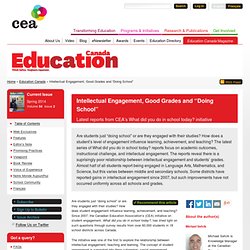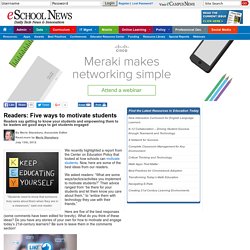

Assessing Critical Thinking in Middle and High Schools. $1.1 million-plus Gates grants: ‘Galvanic’ bracelets that measure student engagement - The Answer Sheet. Posted at 07:00 AM ET, 06/11/2012 Jun 11, 2012 11:00 AM EDT TheWashingtonPost Please see update to this post by clicking here.

In the ‘you-can’t-make-up-this-stuff’ category, the Bill and Melinda Gates Foundation is spending about $1.1 million to develop a way to physiologically measure how engaged students are by their teachers’ lessons. This involves “galvanic skin response” bracelets that kids would wear so their engagement levels could be measured. If this tells us anything, it is that the obsession with measurement and data in school reform has reached new nutty heights. Purpose: to work with members of the Measuring Effective Teachers (MET) team to measure engagement physiologically with Galvanic Skin Response (GSR) bracelets which will determine the feasibility and utility of using such devices regularly in schools with students and teachers. And here’s the description of the $621,265 grant given at the same time to the National Center on Time and Learning:
Intellectual Engagement, Good Grades and “Doing School” Are students just “doing school” or are they engaged with their studies?

How does student engagement influence learning, achievement, and teaching? Since 2007, the Canadian Education Association’s (CEA) initiative on student engagement, What did you do in school today? , has shed light on such questions through survey results from over 60,000 students in 18 school districts across Canada. The initiative was one of the first to explore the relationship between intellectual engagement, teaching and learning.
AWSA - Association of Wisconsin School Administrators: AWSA Update Bulletin - Engagement: The X Factor. Joe Schroeder, Associate Executive Director, AWSA This past fall, Charlotte Danielson was addressing an audience of hundreds of Wisconsin educators, who were participating in the Teacher Effectiveness pilot through DPI.

In her comments, Charlotte pointed to the prominence of one singular component of teaching practice over all others: student engagement. Specifically, she argued that engagement is at the very heart of the learning process, without which substantial learning is not occurring. I suspect most of us would agree. Therefore, cultivating student engagement is perhaps the most important strategy of the would-be effective educator, right? Phil Schlechty has published perhaps the most insightful resource currently available about student engagement. Moreover, given such faulty notions about engagement that are commonly held, the Schlecthy Center has found that educators often confuse engagement with on-task behavior. Www.temescalassociates.com/documents/resources/transition/The Silent Epidemic Perspectives of High School Dropouts.pdf. Engaging Schools: Fostering High School Students' Motivation to Learn.
Readers: Five ways to motivate students. Readers say getting to know your students and empowering them to be leaders are good ways to get students engaged By Meris Stansbury, Associate EditorRead more by Meris Stansbury July 13th, 2012 “Students need to know that someone truly cares about them when they are in a classroom,” said one reader.

We recently highlighted a report from the Center on Education Policy that looked at how schools can motivate students. Now, here are some of the best ideas from our readers. We asked readers: “What are some ways/tactics/activities you implement to motivate students?” Here are five of the best responses (some comments have been edited for brevity). 1. “Like many school librarians and classroom teachers, I capitalize on 21st-century students’ internal motivation to be producers of ideas and information who create for authentic audiences (especially their friends!). 2. How can schools better motivate students? New study sheds light on what works—and what doesn't By Meris Stansbury, Associate Editor Read more by Meris Stansbury June 7th, 2012 "Improving student motivation cannot be accomplished by schools alone," says the report.

It might seem like common sense: To achieve better results, students have to be motivated. But what can schools do about this? A new report from the Center on Education Policy (CEP) aims to answer this question—and it argues that school reform efforts won’t succeed unless they address student motivation. “Motivation is a central part of a student’s educational experience from preschool onward, but it has received scant attention amid an education reform agenda focused mainly on accountability, standards and tests, teacher quality, and school management,” explains the report. Student Motivation: An Overlooked Piece of School Reform, by Alexandra Usher and Nancy Kober at the Center on Education Policy. About the Center on Education Policy: The Center on Education Policy is a national, independent advocate for public education and for more effective public schools.
The Center helps Americans better understand the role of public education in a democracy and the need to improve the academic quality of public schools. We do not represent special interests. Instead, we try to help citizens make sense of the conflicting opinions and perceptions about public education and create the conditions that will lead to better public schools. If you have trouble viewing documents on the Center on Education Policy web site, please: ● Make sure you are using the latest Adobe Reader.